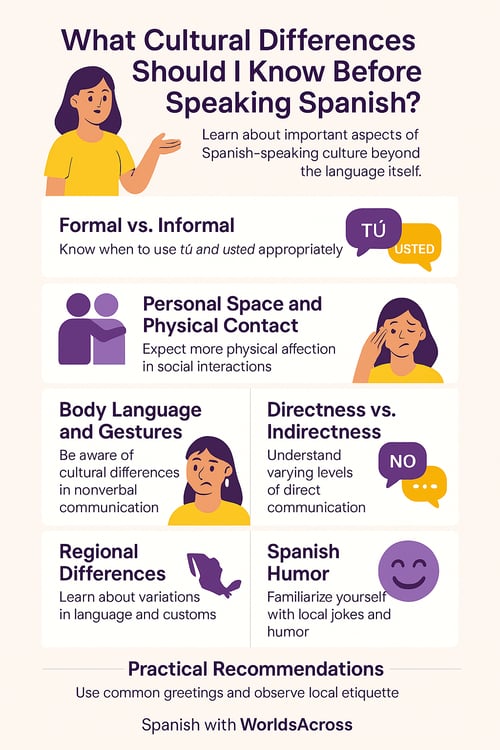What cultural differences should I know before speaking Spanish?
Learning a new language is so much more than memorizing new words. The most important thing you should know about learning a new language is that it goes hand in hand with the culture. This is especially true for Spanish. So, if you’re looking for Spanish-speaking culture tips, you’re in the right place.
When it is time to speak Spanish, you will need more than vocabulary lists and grammar rules. Especially if you are fortunate enough to be speaking Spanish with native speakers or visiting a Spanish-speaking country. Real Spanish can be so much more different than what you would find in a textbook!

Main Spanish-speaking culture tips
Speaking Spanish with native speakers is about so much more than constructing correct sentences. To truly understand the language you need to understand the culture. This includes the way people speak, the choice of words, what people don’t say, and how they express it all.
If you are looking to learn real Spanish, you need to learn more than the words. There are expressions, gestures, traditions, customs, and more intercultural communication Spanish rules. Here are the most important things to know when you’re starting to learn the language.
Formal vs. Informal. Tú vs. Usted
This is a very representative part of the Spanish language. It is also something that tends to confuse new students. Spanish has formality and familiarity encoded in the language, spending on which of these two words you use: Tú vs. Usted.
“Tú” is the informal word, and it’s more commonly used. However, “Usted” is a more formal alternative. While the first one is the standard when addressing friends and family, the second one can be used at work, with strangers, or as a sign of respect.
It can be tricky to get used to switching from “Usted” to “Tú”. Plus, there are regional conditions to consider. Some countries use “Usted” much less, while parts of Colombia, Venezuela, and Central America will use it even in informal settings too!
Remember, “Tú” and “Usted” use different conjugations. So take a look at some useful phrases to guide you:
- Disculpe, ¿Usted sabe dónde queda el aeropuerto?
- ¡Hola! ¿Usted es el profesor de español?
- Amigo, ¿Tú sabes qué hora es?
- ¿Tú quieres ir a la fiesta con nosotros?
Can you see the differences? The first two questions can be addressed to a stranger on the street or as a sign of respect to a teacher. Meanwhile, it can be assumed that the next questions are for a friend in a more informal setting.
Personal space and physical contact
This is a significant part of learning to interact with native Spanish speakers. This isn’t about the written or spoken language, but about physical displays of affection and familiarity. You will notice that people from Spanish cultures tend to be much more physically affectionate than other cultures.
Greeting most people, even new acquaintances with hugs and a kiss on the cheek can be a shock for foreigners. People from more reserved cultures might be thrown off by this. But you can be reassured, this is completely normal in Spanish speaking cultures.
Body language and gestures
It’s a fact that most cultures and countries have distinct gestures that can change meaning in another location. Simply pointing with a finger can be completely normal or disrespectful depending on where in the world you are. Spanish speaking countries also have their unique gestures.
It’s part of intercultural communication Spanish norms to become familiar with these gestures. And they aren’t only hand gestures! For example, pay attention when people frown, raise their eyebrows, scrunch their nose, or even point somewhere using their mouths. It can feel confusing at first, but you’ll get the hang of it.
Directness vs. Indirectness
This is another fact that can feel like a significant difference to people from other cultures. Of course, this may depend on each person. But, in general, people from Spanish-speaking cultures favor being indirect instead of a more blunt approach at communicating.
This means, for example, that saying “no” is often softened to “maybe” or “we’ll see” or similar expressions. When talking about Spanish-speaking culture tips, it’s always a good idea to put some emphasis on being polite and tactful, even if you can’t be very direct.
Regional differences
Spanish is a beautiful and rich language. It is also the official language of 20 different countries. Plus, it is widely spoken all over the world. This means that every little region, as specific as each state of each country, can have its own unique communication customs.
This can be intimidating or confusing, but it’s important to be patient and pay attention to the words and behavior of the people around you wherever you are. For example, simple words can have different meanings in different Spanish-speaking countries.
Most Latin American countries will say “Carro” to refer to a car, but in Spain you’re more likely to hear “Coche”.
Similarly, most countries might say “Bus”, the same as English. In countries like Puerto Rico and Dominican Republic, people call it “Guagua”. But be careful! In Chile, “Guagua” means a baby!
Spanish humor
This is a very important part of Spanish communication customs. Humor and jokes can be very important to people from Spanish-speaking countries. You will find that most people have a good sense of humor and jokes are made constantly in most situations.
However, naturally, most jokes don’t translate easily from English to Spanish and vice versa. It might take time and patience to learn and understand jokes in Spanish, so don’t feel frustrated if you don’t get it at first.
Spanish humor
can be full of wordplay. And, again, each country will probably have its own specific jokes. The best advice is to pay a lot of attention to native speakers.
Be patient, and not try to translate every joke. It’s fine if you don’t get them at first! It’s all part of the learning process.
The importance of greetings
This is something else that people from Spanish-speaking countries do that can be a shock to people from other cultures. People from Spanish cultures can be very polite and they give a lot of importance to greetings especially.
It might seem weird to people from other cultures, but in Spanish-speaking countries it’s normal to say a general greeting whenever you enter a place. You will even see people saying “Buenos días” when entering a bus, an elevator, or just walking past someone in a hallway.
For Spanish-speaking culture tips, you can keep in mind useful little expressions like these:
- Buenos días
- Buenas tardes
- Buenas noches
- Con permiso
- Disculpe
- Buen provecho
- Muchas gracias

There you have it! That’s a great start in intercultural communication Spanish norms. Don’t be intimidated if it seems like a lot. It’s normal to have a lot to learn when you’re dealing with a new language and a completely different culture.
Remember, the most important part is to pay attention to the people around you. You might have heard about some customs, but they could apply only to some countries, and maybe your new friends don’t actually follow those rules. It’s all a matter of patience, practice, and cultural immersion.
The best thing to do is to lead with a good attitude and a lot of respect for the language, the culture, and the people. That’s where you’ll find the best Spanish-speaking culture tips. Don’t forget that you’re learning so much more than a language, you’re learning how to live in Spanish.


